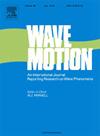Analytical modeling of evanescent coupling in metasurface absorbers for enhanced low-frequency sound control
IF 2.5
3区 物理与天体物理
Q2 ACOUSTICS
引用次数: 0
Abstract
This study presents an analytical approach to model evanescent coupling in planar metasurface absorbers, specifically designed for broadband low-frequency sound absorption. While traditional absorbers rely on thick, wavelength-comparable porous materials, metasurface absorbers with deeply sub-wavelength thickness typically achieve low-frequency absorption using arrays of resonators, such as Helmholtz resonators, folded quarter-wavelength resonators, or backed micro-perforated panels. Standard surface-impedance-based models of metasurface absorbers often ignore inter-resonator coupling effects, leading to inaccuracies in frequency response predictions. Our method incorporates evanescent wave interactions between resonators, whether rectangular or circular in cross-section, arranged in regular super-cells that can repeat periodically or with mirror symmetry, which also corresponds to one super-cell placed in a rigid-walled rectangular waveguide (impedance tube). This approach reduces computational complexity significantly compared to finite element simulations, while still enabling accurate predictions of metasurface absorbing performance. Validated through comparison with two numerical finite element models, this analytical method proves effective for optimizing metasurface absorbers for low-frequency sound control. Numerical experiments further illustrate performance degradation from neglecting evanescent coupling or mismatched super-cell periodicity. Implementation MATLAB code is available on https://github.com/MilanCervenka/Evanescent.
增强低频声控制的超表面吸收器中倏逝耦合的分析建模
本研究提出了一种分析方法来模拟专为宽带低频吸声而设计的平面超表面吸声器中的倏逝耦合。传统的吸收器依赖于厚的、波长相当的多孔材料,而具有深度亚波长厚度的超表面吸收器通常使用谐振器阵列来实现低频吸收,例如亥姆霍兹谐振器、折叠四分之一波长谐振器或背面微穿孔板。标准的基于表面阻抗的超表面吸收器模型经常忽略谐振腔间耦合效应,导致频率响应预测不准确。我们的方法结合了谐振器之间的倏逝波相互作用,无论是矩形还是圆形的横截面,排列在规则的超级细胞中,这些超级细胞可以周期性地重复或具有镜像对称性,这也对应于放置在刚性壁矩形波导(阻抗管)中的一个超级细胞。与有限元模拟相比,这种方法大大降低了计算复杂度,同时仍然能够准确预测超表面吸收性能。通过与两种数值有限元模型的比较,验证了该分析方法对低频声控制超表面吸波器的优化是有效的。数值实验进一步说明了忽略倏逝耦合或不匹配的超胞周期会导致性能下降。实现MATLAB代码可在https://github.com/MilanCervenka/Evanescent上获得。
本文章由计算机程序翻译,如有差异,请以英文原文为准。
求助全文
约1分钟内获得全文
求助全文
来源期刊

Wave Motion
物理-力学
CiteScore
4.10
自引率
8.30%
发文量
118
审稿时长
3 months
期刊介绍:
Wave Motion is devoted to the cross fertilization of ideas, and to stimulating interaction between workers in various research areas in which wave propagation phenomena play a dominant role. The description and analysis of wave propagation phenomena provides a unifying thread connecting diverse areas of engineering and the physical sciences such as acoustics, optics, geophysics, seismology, electromagnetic theory, solid and fluid mechanics.
The journal publishes papers on analytical, numerical and experimental methods. Papers that address fundamentally new topics in wave phenomena or develop wave propagation methods for solving direct and inverse problems are of interest to the journal.
 求助内容:
求助内容: 应助结果提醒方式:
应助结果提醒方式:


